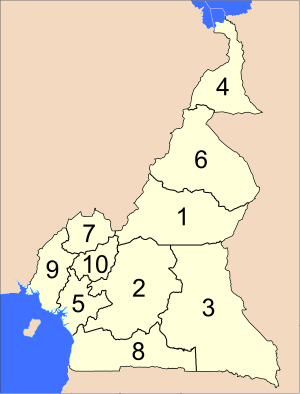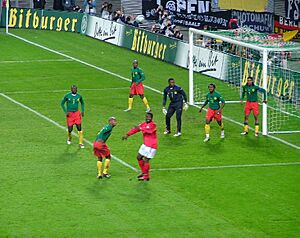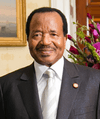Cameroon facts for kids
Quick facts for kids
Republic of Cameroon
République du Cameroun (French)
|
|
|---|---|
|
|
|
|
Anthem:
"Ô Cameroun, berceau de nos ancêtres" (French) "O Cameroon, Cradle of Our Forefathers" |
|
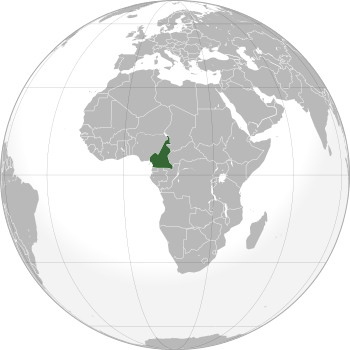 |
|
| Capital | Yaoundé 3°52′N 11°31′E / 3.867°N 11.517°E |
| Largest city | Douala |
| Official languages | English • French |
| Ethnic groups
(2022)
|
|
| Religion
(2022)
|
|
| Demonym(s) | Cameroonian |
| Government | Unitary dominant-party presidential republic under a dictatorship |
| Paul Biya | |
| Joseph Ngute | |
|
• President of Senate
|
Marcel Niat Njifenji |
| Legislature | Parliament |
| Senate | |
| National Assembly | |
| Independence
from France and the United Kingdom
|
|
|
• Independence from France
|
1 January 1960 |
|
• Independence from the United Kingdom
|
1 October 1961 |
| Area | |
|
• Total
|
475,442 km2 (183,569 sq mi) (53rd) |
|
• Water (%)
|
0.57 |
| Population | |
|
• 2024 estimate
|
30,966,105 (52nd) |
|
• Density
|
39.7/km2 (102.8/sq mi) |
| GDP (PPP) | 2024 estimate |
|
• Total
|
|
|
• Per capita
|
|
| GDP (nominal) | 2024 estimate |
|
• Total
|
|
|
• Per capita
|
|
| Gini (2021) | ▼ 42.2 medium |
| HDI (2022) | medium · 151st |
| Currency | Central African CFA franc (XAF) |
| Time zone | UTC+1 (WAT) |
| Date format | dd/mm/yyyy yyyy/mm/dd |
| Driving side | right |
| Calling code | +237 |
| ISO 3166 code | CM |
| Internet TLD | .cm |
Cameroon (officially called the Republic of Cameroon) is a country in west Africa. Its capital is Yaoundé. The largest city in Cameroon is Douala. The population of Cameroon is about 20 million. Cameroon's president is Paul Biya. They speak nearly 250 languages in Cameroon. French and English are the official languages.
Contents
History
Early inhabitants of the territory included the Sao civilisation around Lake Chad and the Baka hunter-gatherers in the southeastern rainforest. Portuguese explorers reached the coast in the 15th century and named the area Rio dos Camarões (Shrimp River), which became Cameroon in English. Fulani soldiers founded the Adamawa Emirate in the north in the 19th century, and various ethnic groups of the west and northwest established powerful chiefdoms and fondoms.
Cameroon became a German colony in 1884 known as Kamerun. After World War I, it was divided between France and the United Kingdom as League of Nations mandates. France took 4/5 and the United Kingdom 1/5 of the territory and both ruled it under mandate until independence in 1960 and 1961 respectively. The Union des Populations du Cameroun (UPC) political party advocated independence but was outlawed by France in the 1950s, leading to the national liberation insurgency fought between French and UPC militant forces until early 1971. In 1960, the French-administered part of Cameroon became independent, as the Republic of Cameroun, under President Ahmadou Ahidjo. The southern part of British Cameroons federated with it in 1961 to form the Federal Republic of Cameroon. The federation was abandoned in 1972. The country was renamed the United Republic of Cameroon in 1972 and back to the Republic of Cameroon in 1984 by a presidential decree by president Paul Biya.
Geography
At 475,442 square kilometres (183,569 sq mi), Cameroon is the world's 53rd-largest country. The country is located in Central Africa, on the Bight of Bonny, part of the Gulf of Guinea and the Atlantic Ocean. Cameroon lies between latitudes 1° and 13°N, and longitudes 8° and 17°E. Cameroon controls 12 nautical miles of the Atlantic Ocean.
Tourist literature describes Cameroon as "Africa in miniature" because it exhibits all major climates and vegetation of the continent: coast, desert, mountains, rainforest, and savanna. The country's neighbours are Nigeria and the Atlantic Ocean to the west; Chad to the northeast; the Central African Republic to the east; and Equatorial Guinea, Gabon and the Republic of the Congo to the south.
Cameroon is divided into five major geographic zones distinguished by dominant physical, climatic, and vegetative features. The coastal plain extends 15 to 150 kilometres (9 to 93 mi) inland from the Gulf of Guinea and has an average elevation of 90 metres (295 ft). Exceedingly hot and humid with a short dry season, this belt is densely forested and includes some of the wettest places on earth, part of the Cross-Sanaga-Bioko coastal forests.
The South Cameroon Plateau rises from the coastal plain to an average elevation of 650 metres (2,133 ft). Equatorial rainforest dominates this region, although its alternation between wet and dry seasons makes it less humid than the coast. This area is part of the Atlantic Equatorial coastal forests ecoregion.
An irregular chain of mountains, hills, and plateaus known as the Cameroon range extends from Mount Cameroon on the coast—Cameroon's highest point at 4,095 metres (13,435 ft)—almost to Lake Chad at Cameroon's northern border at 13°05'N. This region has a mild climate, particularly on the Western High Plateau, although rainfall is high. Its soils are among Cameroon's most fertile, especially around volcanic Mount Cameroon. Volcanism here has created crater lakes. On 21 August 1986, one of these, Lake Nyos, belched carbon dioxide and killed between 1,700 and 2,000 people. This area has been delineated by the World Wildlife Fund as the Cameroonian Highlands forests ecoregion.
The southern plateau rises northward to the grassy, rugged Adamawa Plateau. This feature stretches from the western mountain area and forms a barrier between the country's north and south. Its average elevation is 1,100 metres (3,609 ft), and its average temperature ranges from 22 °C (71.6 °F) to 25 °C (77 °F) with high rainfall between April and October peaking in July and August. The northern lowland region extends from the edge of the Adamawa to Lake Chad with an average elevation of 300 to 350 metres (984 to 1,148 ft). Its characteristic vegetation is savanna scrub and grass. This is an arid region with sparse rainfall and high median temperatures.
Cameroon has four patterns of drainage. In the south, the principal rivers are the Ntem, Nyong, Sanaga, and Wouri. These flow southwestward or westward directly into the Gulf of Guinea. The Dja and Kadéï drain southeastward into the Congo River. In northern Cameroon, the Bénoué River runs north and west and empties into the Niger. The Logone flows northward into Lake Chad, which Cameroon shares with three neighbouring countries.
Wildlife
Cameroon's wildlife is composed of its flora and fauna. It is one of the wettest parts of Africa and records Africa's second highest concentration of biodiversity. In Cameroon forest cover is around 43% of the total land area, equivalent to 20,340,480 hectares (ha) of forest in 2020, down from 22,500,000 hectares (ha) in 1990. In 2020, naturally regenerating forest covered 20,279,380 hectares (ha) and planted forest covered 61,100 hectares (ha). Around 15% of the forest area was found within protected areas, for the year 2015, 100% of the forest area was reported to be under public ownership.
To preserve its wildlife, Cameroon has more than 20 protected reserves comprising national parks, zoos, forest reserves and sanctuaries. The protected areas were first created in the northern region under the colonial administration in 1932; the first two reserves established were Mozogo Gokoro Reserve and the Bénoué Reserve, which was followed by the Waza Reserve on 24 March 1934. The coverage of reserves was initially about 4 percent of the country's area, rising to 12 percent; the administration proposes to cover 30 percent of the land area.
Its rich wildlife consists of 8,260 recorded plant species including 156 endemic species, 409 species of mammals of which 14 are endemic, 690 species of birds which includes 8 endemic species, 250 species of reptiles, and 200 species of amphibians. The habitats of these species include the southern region comprising tropical lowland, coastline on the Gulf of Guinea. Mangrove forests, 270,000 hectares (670,000 acres) in size, are along the coast line. Montane forests and savannas are in the northern region of the country. Important protected areas for these species are the Mbam Djerem National Park, Benoue National Park, Korup National Park, Takamanda National Park, and the Kagwene Gorilla Sanctuary. Cameroon is an important breeding area for marine and freshwater species such as crustaceans, mollusks, fish, and birds.
Regions
The constitution divides Cameroon into 10 regions. On 12 November 2008, the President changed the divisions from provinces to regions. Each region is headed by a presidentially appointed governor.
The regions are divided into 58 divisions. These are headed by presidentially appointed divisional officers.
|
Cities
Some of the largest cities in Cameroon are:
| Ranking | Name | Population |
|---|---|---|
| 1. | Douala | 2,000,000 |
| 2. | Yaoundé | 1,600,000 |
| 3. | Garoua | 450,000 |
| 4. | Bafoussam | 350,000 |
| 5. | Maroua | 327,000 |
| 6. | Bamenda | 299,600 |
| 7. | Ngaoundéré | 185,700 |
Culture
Music and dance
Music and dance are integral parts of Cameroonian ceremonies, festivals, social gatherings, and storytelling. Traditional dances are highly choreographed and separate men and women or forbid participation by one sex altogether. The dances' purposes range from pure entertainment to religious devotion. Traditionally, music is transmitted orally. In a typical performance, a chorus of singers echoes a soloist.
Musical accompaniment may be as simple as clapping hands and stamping feet, but traditional instruments include bells worn by dancers, clappers, drums and talking drums, flutes, horns, rattles, scrapers, stringed instruments, whistles, and xylophones; combinations of these vary by ethnic group and region. Some performers sing complete songs alone, accompanied by a harplike instrument.
Popular music styles include ambasse bey of the coast, assiko of the Bassa, mangambeu of the Bangangte, and tsamassi of the Bamileke. Nigerian music has influenced Anglophone Cameroonian performers, and Prince Nico Mbarga's highlife hit "Sweet Mother" is the top-selling African record in history.
The two most popular music styles are makossa and bikutsi. Makossa developed in Douala and mixes folk music, highlife, soul, and Congo music. Performers such as Manu Dibango, Francis Bebey, Moni Bilé, and Petit-Pays popularised the style worldwide in the 1970s and 1980s. Bikutsi originated as war music among the Ewondo. Artists such as Anne-Marie Nzié developed it into a popular dance music beginning in the 1940s, and performers such as Mama Ohandja and Les Têtes Brulées popularised it internationally during the 1960s, 1970s and 1980s.
Holidays
The most notable holiday associated with patriotism in Cameroon is National Day, also called Unity Day. Among the most notable religious holidays are Assumption Day, and Ascension Day, which is typically 39 days after Easter. In the Northwest and Southwest provinces, collectively called Ambazonia, October 1 is considered a national holiday, a date Ambazonians consider the day of their independence from Cameroon.
Cuisine
Cuisine varies by region, but a large, one-course, evening meal is common throughout the country. A typical dish is based on cocoyams, maize, cassava (manioc), millet, plantains, potatoes, rice, or yams, often pounded into dough-like fufu. This is served with a sauce, soup, or stew made from greens, groundnuts, palm oil, or other ingredients. Meat and fish are popular but expensive additions, with chicken often reserved for special occasions. Dishes are often quite spicy; seasonings include salt, red pepper sauce, and maggi.
Cutlery is common, but food is traditionally manipulated with the right hand. Breakfast consists of leftovers of bread and fruit with coffee or tea. Generally, breakfast is made from wheat flour in various different foods such as puff-puff (doughnuts), accra banana made from bananas and flour, bean cakes, and many more. Snacks are popular, especially in larger towns where they may be bought from street vendors.
Fashion
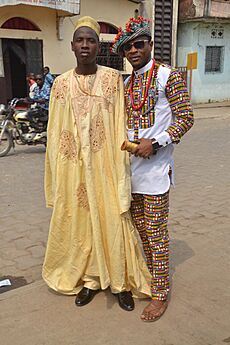
Cameroon's relatively large and diverse population is likewise diverse in its fashions. Climate, religious, ethnic and cultural beliefs, and the influences of colonialism, imperialism, and globalisation are all factors in contemporary Cameroonian dresses. Noteworthy Cameroonians dresses include Pagnes, sarongs worn by Cameroon women; Chechia, a traditional hat; kwa, a male handbag; and Gandura, male custom attire. Wrappers and loincloths are used extensively by both women and men but their use varies by region, with influences from Fulani styles more present in the north and Igbo and Yoruba styles more often in the south and west. Imane Ayissi is one of Cameroon's most prominent fashion designers and has received international recognition.
Local arts and crafts
Traditional arts and crafts are practised throughout the country for commercial, decorative, and religious purposes. Woodcarvings and sculptures are especially common. The high-quality clay of the western highlands is used for pottery and ceramics. Other crafts include basket weaving, beadworking, brass and bronze working, calabash carving and painting, embroidery, and leather working. Traditional housing styles use local materials and vary from temporary wood-and-leaf shelters of nomadic Mbororo to the rectangular mud-and-thatch homes of southern peoples. Dwellings of materials such as cement and tin are increasingly common. Contemporary art is mainly promoted by independent cultural organizations (Doual'art, Africréa) and artist-run initiatives (Art Wash, Atelier Viking, ArtBakery).
Literature
Cameroonian literature has concentrated on both European and African themes. Colonial-era writers such as Louis-Marie Pouka and Sankie Maimo were educated by European missionary societies and advocated assimilation into European culture to bring Cameroon into the modern world. After World War II, writers such as Mongo Beti and Ferdinand Oyono analysed and criticised colonialism and rejected assimilation.
Media
- Cameroon Radio Television
Films and literature
Shortly after independence, filmmakers such as Jean-Paul Ngassa and Thérèse Sita-Bella explored similar themes. In the 1960s, Mongo Beti, Ferdinand Léopold Oyono and other writers explored postcolonialism, problems of African development, and the recovery of African identity. In the mid-1970s, filmmakers such as Jean-Pierre Dikongué Pipa and Daniel Kamwa dealt with the conflicts between traditional and postcolonial society. Literature and films during the next two decades focused more on wholly Cameroonian themes.
Sports
National policy strongly advocates sport in all forms. Traditional sports include canoe racing and wrestling, and several hundred runners participate in the 40 km (25 mi) Mount Cameroon Race of Hope each year. Cameroon is one of the few tropical countries to have competed in the Winter Olympics.
Sport in Cameroon is dominated by football. Amateur football clubs abound, organised along ethnic lines or under corporate sponsors. The national team has been one of the most successful in Africa since its strong showing in the 1982 and 1990 FIFA World Cups. Cameroon has won five African Cup of Nations titles and the gold medal at the 2000 Olympics.
Cameroon was the host country of the Women Africa Cup of Nations in November–December 2016, the 2020 African Nations Championship and the 2021 Africa Cup of Nations. The women's football team is known as the "Indomitable Lionesses", and like their men's counterparts, are also successful at international stage, although it has not won any major trophy.
Cricket has also entered into Cameroon as an emerging sport with the Cameroon Cricket Federation participating in international matches Cameroon has produced multiple National Basketball Association players including Pascal Siakam, Joel Embiid, D. J. Strawberry, Ruben Boumtje-Boumtje, Christian Koloko, and Luc Mbah a Moute. The former UFC Heavyweight Champion, Francis Ngannou, hails from Cameroon.
Related pages
Images for kids
-
Former president Ahmadou Ahidjo ruled from 1960 until 1982.
-
Paul Biya has ruled the country since 1982.
-
Our Lady of Victories Cathedral, catholic church in Yaoundé
See also
 In Spanish: Camerún para niños
In Spanish: Camerún para niños






